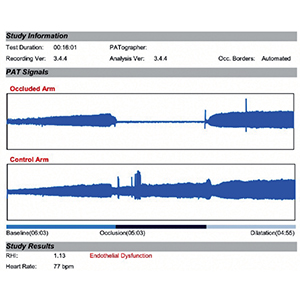Endothelial dysfunction in COVID-19 patients assessed with Endo-PAT2000

Published: February 17, 2022
Abstract Views: 2104
PDF: 497
Publisher's note
All claims expressed in this article are solely those of the authors and do not necessarily represent those of their affiliated organizations, or those of the publisher, the editors and the reviewers. Any product that may be evaluated in this article or claim that may be made by its manufacturer is not guaranteed or endorsed by the publisher.
All claims expressed in this article are solely those of the authors and do not necessarily represent those of their affiliated organizations, or those of the publisher, the editors and the reviewers. Any product that may be evaluated in this article or claim that may be made by its manufacturer is not guaranteed or endorsed by the publisher.
Similar Articles
- Elio Gorga, Marta Scodro, Francesca Valentini, Renzo D'Ortona, Mariachiara Arisi, Edoardo Sciatti, Ivano Bonadei, Valentina Regazzoni, Enrico Vizzardi, Marco Metra, Piergiacomo Calzavara Pinton, Echocardiographic evaluation of diastolic dysfunction in young and healthy patients with psoriasis: A case-control study , Monaldi Archives for Chest Disease: Vol. 88 No. 3 (2018)
- Neeta Singla, Amitesh Gupta, U.K. Khalid, Ravindra Kumar Dewan, Rupak Singla, Clinical profile, risk factors, disease severity, and outcome for COVID-19 disease in patients with tuberculosis on treatment under the National Tuberculosis Elimination Program: a cohort of 1400 patients , Monaldi Archives for Chest Disease: Early Access
- Samuele Baldasseroni, Alessandra Pratesi, Francesco Orso, Claudia Di Serio, Alice Foschini, Andrea Giosafat Marella, Nadia Bartoli, Mauro Di Bari, Stefano Fumagalli, Niccolò Marchionni, Francesca Tarantini, Epicardial adipose tissue and insulin resistance in patients with coronary artery disease with or without left ventricular dysfunction , Monaldi Archives for Chest Disease: Vol. 80 No. 4 (2013): Cardiac Series
- Donatella Ruggiero, Stefania Paolillo, Giuseppe Della Ratta, Antonio Mariniello, Tiziana Formisano, Angela Maria Pellegrino, Pasquale Perrone Filardi, Endothelial function as a marker of pre-clinical atherosclerosis: assessment techniques and clinical implications , Monaldi Archives for Chest Disease: Vol. 80 No. 3 (2013): Cardiac series
- Francesco Giallauria, Anna De Lorenzo, Athanasio Manakos, Francesco Pilerci, Marianna Psaroudaki, Alessandro De Cristofaro, Rosa Lucci, Domenico Del Forno, Carlo Vigorito, Inflammatory syndrome after thoracic aortic endoprothesis implantation associated with cortico-surrenal adenoma , Monaldi Archives for Chest Disease: Vol. 64 No. 1 (2005): Cardiac series
- Igor Sergeevich Mamenko, Igor V. Vasilev, Roman V. Simonov, Anna S. Zakharova, Pavel V. Gavrilov, Ivetta V. Dvorakovskaya, Tatiana A. Novitskaya, Petr K. Yablonskiy, Probe-based confocal laser endomicroscopy in the diagnosis of diffuse cystic lung disease in Sjögren’s syndrome , Monaldi Archives for Chest Disease: Vol. 94 No. 3 (2024)
- Maria Teresa Manes, Manlio Gagliardi, Gianfranco Misuraca, Stefania Rossi, Mario Chiatto, Left ventricular geometric patterns and cardiac function in patients with chronic renal failure undergoing hemodialysis , Monaldi Archives for Chest Disease: Vol. 64 No. 1 (2005): Cardiac series
- Rosa Spezzaferri, Maddalena Modica, Vittorio Racca, Vittorino Ripamonti, Monica Tavanelli, Gabriella Brambilla, Maurizio Ferratini, Psychological disorders after coronary artery by-pass surgery: a one-year prospective study , Monaldi Archives for Chest Disease: Vol. 72 No. 4 (2009): Cardiac series
- Luigi Maresca, Mariantonietta D’Agostino, Luigi Castaldo, Alessandra Vitelli, Maria Mancini, Giorgio Torella, Rosa Lucci, Giovanna Albano, Domenico Del Forno, Matteo Ferro, Vincenzo Altieri, Francesco Giallauria, Carlo Vigorito, Exercise training improves erectile dysfunction (ED) in patients with metabolic syndrome on phosphodiesterase-5 (PDE-5) inhibitors , Monaldi Archives for Chest Disease: Vol. 80 No. 4 (2013): Cardiac Series
- Gabriella Malfatto, Paola Cuoccio, Caterina Bizzi, Giovanna Branzi, Alessandra Villani, Francesco Della Rosa, Gianfranco Parati, Mario Facchini, What underlies NYHA class in elderly patients with heart failure? role of diastolic dysfunction, functional mitral regurgitation and abnormal ventilation during exercise , Monaldi Archives for Chest Disease: Vol. 72 No. 2 (2009): Cardiac series
You may also start an advanced similarity search for this article.

 https://doi.org/10.4081/monaldi.2022.2213
https://doi.org/10.4081/monaldi.2022.2213





